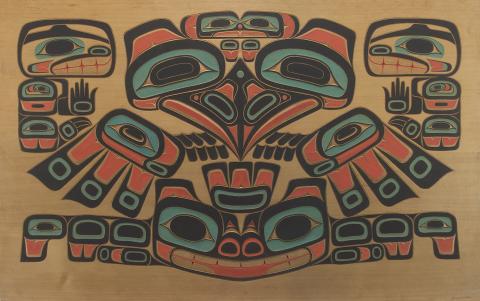Raven and Sculpin Panel
This carved and painted yellow cedar depicts a T’akdeintaan story that involves a Raven and a Sculpin or bullhead. This piece comes from the transitional period that followed the classical period. The classical period ended when Christianity outlawed the art, and the master-apprentice relationships were forced to stop. Artists like Lincoln had to learn their craft without the guidance of mentor artists. The grammar of the art became lost and while these men struggled to do pieces they had seen or heard about the art changed by not having the guidance of an experienced artist to critique their efforts. An aspect of this time period was disconnected formline as this piece shows. So even though transitional art deviated from classical period pieces, a lot of respect is owed to these artists who held on to this art by any way they could to prevent it from being eradicated.
This piece was completed in 1963, right at the end of the transitional period and right before the great awakening where the canon of the art was rediscovered, and the master-apprentice system was brought back.
Artists had many different types of wood to carve with and the choice was made as to which type to use by defining what function the item the item will serve and/or depict. Yellow cedar was often chosen for its ease of carving and for how well it would take detail.
It was important to immortalize clan history, commemorate events, describe lineages, display rights to certain territories and other aspects of their culture through art. These forms of artistically modified inanimate objects served as portals to the spiritual world and allowed ancient ancestors to take part in the lives of their living descendants. Items that are produced for clan use were called at.oowu and were taken care of by special care takers that made sure these things would be handed down to successive generations. At.oowu were treated with reverence and carried deep emotional attachments from its associated clan members.
Formerly in the collection held by the Indian Arts and Crafts Board Office in Sitka, Alaska, which included many pieces produced and acquired during IACB demonstration-workshops held in Sitka between 1962 and 1968; transferred to the IACB Headquarters collection in Washington, DC, in 1969; part of the IACB Headquarters collection (Department of the Interior, Washington, DC) until 2000 when it was transferred to NMAI.

